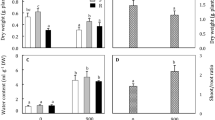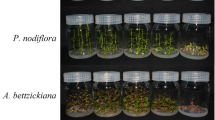Abstract
We examined the physiological and biochemical responses of two halophytic grasses with different photosynthetic pathways, Puccinellia tenuiflora (C3) and Chloris virgata (C4), to saline-alkaline stresses. Plants were grown at different Na2CO3 concentrations (from 0 to 200 mM). Low Na2CO3 (< 12.5 mM) enhanced seed germination and plant growth, whereas high Na2CO3 concentrations (> 100 mM) reduced seed germination by 45% in P. tenuiflora and by 30% in C. virgata. Compared to C. virgata, P. tenuiflora showed lower net photosynthesis, stomatal conductance, intercellular CO2 concentration, and water-use efficiency under the same treatment. C. virgata exhibited also relatively higher ATP content, K+ concentration, and the K+/Na+ ratio under the stress treatments implying that salt tolerance may be the main mechanism for salt resistance in this species. Our results demonstrated that the C. virgata was relatively more resistant to saline-alkaline stress than the co-occurring P. tenuiflora; both two species adapt to their native saline-alkaline habitat by different physiological mechanisms.
Similar content being viewed by others
Abbreviations
- C i :
-
intercellular CO2 concentration
- g s :
-
stomatal conductance
- E :
-
transpiration rate
- EC:
-
electrical conductivity
- P N :
-
net photosynthetic rate
- RDM:
-
relative dry mass
- REL:
-
rate of electrolyte leakage
- RPH:
-
relative plant height
- SGP:
-
seed germination percentage
- WUE:
-
water-use efficiency
References
Bandurska H.: Does proline accumulated in leaves of water deficit stressed barley plants confine cell membrane injury? I. Free proline accumulation and membrane injury index in drought and osmotically stressed plants. — Acta Physiol. Plant. 22: 409–415, 2000.
Barkla B.J., Zingarelli L., Blumwald E., Smith J.A.C.: Tonoplast Na+/H+ antiport activity and its energization by the vacuolar H+-ATPase in the halophytic plant Mesembryanthemum crystallinum L. — Plant Physiol. 109: 549–556, 1995.
Campbell S.A., Nishio J.N.: Ion deficiency studies of sugar beet using an improved sodium bicarbonate-buffered hydroponics growth system. — J. Plant Nutr. 23: 741–757, 2000.
Cheeseman J.M.: Mechanisms of salinity tolerance in plants. — Plant Physiol. 87: 547–550, 1988.
Chen L., Wang R.Z.: Anatomical and physiological divergences and compensatory effects in two Leymus chinensis (Poaceae) ecotypes in Northeast China. — Agr. Ecosyst. Environ. 134: 46–52, 2009.
Cornic G.: Drought stress inhibits photosynthesis by decreasing stomatal aperture — not by affecting ATP synthesis. — Trends Plant Sci. 5: 187–188, 2000.
Cuin T.A., Bose J., Stefano G. et al.: Assessing the role of root plasma membrane and tonoplast Na+/H+ exchangers in salinity tolerance in wheat: in planta quantification methods. — Plant Cell Environ. 34: 947–961, 2011.
Degenhardt B., Gimmler H., Hose E., Hartung W.: Effect of alkaline and saline substrates on ABA contents, distribution and transport in plant roots. — Plant Soil 225: 83–94, 2000.
Du X.G.., Zheng H.Y., Liu C.D.: [A preliminary study on the main plant communities in the saline soils of Songnen plain.] — Acta Phytoecol. Sin. 18: 41–49, 1994. [In Chinese]
Flowers T.J., Colmer T.D.: Salinity tolerance in halophytes. — New Phytol. 179: 945–963, 2008.
Garthwaite A.J., von Bothmer R., Colmer T.D.: Salt tolerance in wild Hordeum species is associated with restricted entry of Na+ and Cl− into the shoots. — J. Exp. Bot. 56: 2365–2378, 2005.
Ge Y., Li J.D.: Studies on the characteristics of K+, Na+ content in Aneurolepidium chinense grassland of Northeast China. — Acta Bot. Sin. 34: 169–175, 1992.
Irigoyen J.J., Emerich D.W., Sánchez-Díaz M.: Water-stress induced changes in concentrations of proline and total soluble sugars in nodulated alfalfa (Medicago sativa) plants. — Physiol. Plant. 84: 55–60, 1992.
Lawlor D.W., Cornic G.: Photosynthetic carbon assimilation and associated metabolism in relation to water deficits in higher plants. — Plant Cell Environ. 25: 275–294, 2002.
Li J.D., Zheng H.Y. (ed.): [Improvement of Saline Grasslands in the Songnen Plain and Ecological Mechanisms.] Pp. 270. Science Press, Beijing 1997. [In Chinese]
Martínez J.P., Kinet J.M., Bajji M., Lutts S.: NaCl alleviates polyethylene glycol-induced water stress in halophyte species Atriplex halimus L. — J. Exp. Bot. 56: 2421–2431, 2005.
Munns R., James R.A., Läuchli A.: Approaches to increasing the salt tolerance of wheat and other cereals. — J. Exp. Bot. 57: 1025–1043, 2006.
Peng Y.H., Zhu Y.F., Mao Y.Q. et al.: Alkali grass resists salt stress through high [K+] and an endodermis barrier to Na+. — J. Exp. Bot. 55: 939–949, 2004.
Shi D.C., Wang D.L.: Effects of various salt-alkaline mixed stresses on Aneurolepidium chinense (Trin.) Kitag. — Plant Soil 271: 15–26, 2005.
Shi D.C., Yin L.J.: Difference between salt (NaCl) and alkaline (Na2CO3) stresses on Puccinellia tenuiflora (Griseb.) Scrib. et Merr. plants. — Acta Bot. Sin. 35: 144–149, 1993.
Tezara W., Mitchell V.J., Driscoll S.D., Lawlor D.W.: Water stress inhibits plant photosynthesis by decreasing coupling factor and ATP. — Nature 401: 914–917, 1999.
Wang H.F., Zhang J.H., Liang J.S., Yin W.L.: Responses of woody plant root and xylem sap ATP to soil drying. — Chinese Sci. Bull. 44: 1172–1178, 1999.
Wang R.Z.: Plant functional types and their ecological responses to salinization in saline grasslands, Northeastern China. — Photosynthetica 42: 511–519, 2004.
Ward J.M., Hirschi K.D., Sze H.: Plants pass the salt. — Trends Plant Sci. 8: 200–201, 2003.
Xiong, Y., Li Q.D. (ed.): [China Soil.] Pp. 643. Science Press, China 1978. [In Chinese]
Author information
Authors and Affiliations
Corresponding author
Additional information
Acknowledgements: We would like to thank Y.Q. Yuan for being a help to the experiment. The work was supported by National Scientific Foundation of China (31170304, 31070228).
Rights and permissions
About this article
Cite this article
Guo, C.Y., Wang, X.Z., Chen, L. et al. Physiological and biochemical responses to saline-alkaline stress in two halophytic grass species with different photosynthetic pathways. Photosynthetica 53, 128–135 (2015). https://doi.org/10.1007/s11099-015-0094-5
Received:
Accepted:
Published:
Issue Date:
DOI: https://doi.org/10.1007/s11099-015-0094-5




